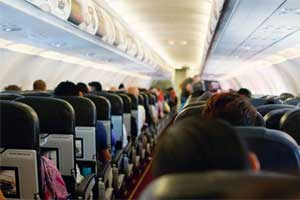- Home
- Editorial
- News
- Practice Guidelines
- Anesthesiology Guidelines
- Cancer Guidelines
- Cardiac Sciences Guidelines
- Critical Care Guidelines
- Dentistry Guidelines
- Dermatology Guidelines
- Diabetes and Endo Guidelines
- Diagnostics Guidelines
- ENT Guidelines
- Featured Practice Guidelines
- Gastroenterology Guidelines
- Geriatrics Guidelines
- Medicine Guidelines
- Nephrology Guidelines
- Neurosciences Guidelines
- Obs and Gynae Guidelines
- Ophthalmology Guidelines
- Orthopaedics Guidelines
- Paediatrics Guidelines
- Psychiatry Guidelines
- Pulmonology Guidelines
- Radiology Guidelines
- Surgery Guidelines
- Urology Guidelines
Insight into management of in-flight medical emergencies: JAMA

An increasing number of in-flight emergencies (IMEs) have once again stressed the importance of proper assisting of patients in the flight. While physicians are often asked to assist the flight team and affected patients, many of them have the limited experience of respond in lieu of a complex environment with limited medical resources.
In a new review published in the journal JAMA, the researchers have tried to address this knowledge gap wherein they provide guidance on assisting medical professionals to encounter such an event with ease.
The review, conducted by Christian Martin-Gill, Department of Emergency Medicine, the University of Pittsburgh Medical Center, Pittsburgh, Pennsylvania, and colleagues, informed by both literature and the authors’ insights into providing airline care guidance for IMEs, details the most common IMEs and provides information on how to manage these.
"In-flight medical emergencies are estimated to occur in approximately 1 per 604 flights, or 24 to 130 IMEs per 1 million passengers. These events happen in a unique environment, with airplane cabin pressurization equivalent to an altitude of 5000 to 8000 ft during flight, exposing patients to a low partial pressure of oxygen and low humidity," write the authors.
Some Key Points of the Study:
- The most common IMEs involve syncope or near-syncope (32.7%) and gastrointestinal (14.8%), respiratory (10.1%), and cardiovascular (7.0%) symptoms.
- Less common IMEs include trauma, psychiatric symptoms, substance abuse and withdrawal, allergic reactions, obstetric emergencies, and cardiac arrest.
- Diversion of the aircraft from landing at the scheduled destination to a different airport because of a medical emergency occurs in an estimated 4.4% (95% CI, 4.3%-4.6%) of IMEs.
- Medical volunteers should identify their background and skills, perform an assessment, and report findings to ground-based medical support personnel through the flight crew. Ground-based recommendations ultimately guide interventions on board.
"In-flight medical emergencies most commonly involve near-syncope and gastrointestinal, respiratory, and cardiovascular symptoms. Health care professionals can assist during these emergencies as part of a collaborative team involving the flight crew and ground-based physicians," concluded the authors.
For further reference log on to 10.1001/jama.2018.19842

Disclaimer: This site is primarily intended for healthcare professionals. Any content/information on this website does not replace the advice of medical and/or health professionals and should not be construed as medical/diagnostic advice/endorsement or prescription. Use of this site is subject to our terms of use, privacy policy, advertisement policy. © 2020 Minerva Medical Treatment Pvt Ltd